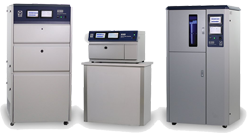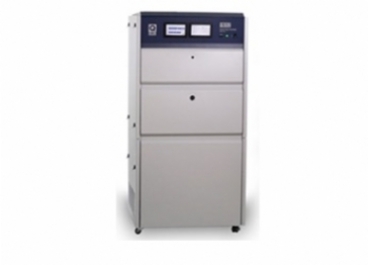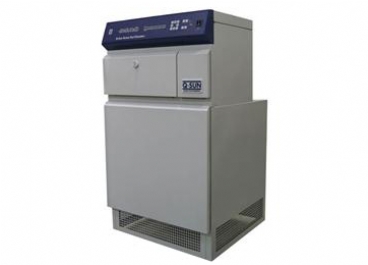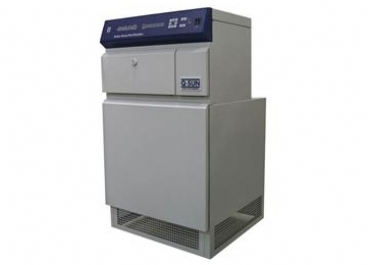耐候性试验
Weathering Testing
咨询热线
18566398802GMW 3414-2002
GMW 3414-2002标准介绍
1 Scope
This test method shall be used to determine the effects of weathering using a xenon-arc lamp source(artificial sunlight) to simulate extreme environmentalconditions encountered inside a vehicle due to sunlight, heat and humidity. This method shall be used toevaluate the colorfastness, as well as being the artificial weathering method to evaluate degradation.
Note:Nothing in this test method supersedes applicable laws and regulations unless a specific exemption has been obtained.
Note:In the event of a conflict between the English and the domestic language, the English languageshall take precedence.
2 References
Note: Only the latest approved standards are applicable unless otherwise specified.
2.1 Normative.
ISO 105-A02
2.2 GM.
GMW6992
2.3Additional.
Equipment Manufacturer's Operating Manuals
3Test Equipment
3.1 Xenon-Arc Weathering Device. The weathering device shall consist of a climatic chamber madefrom corrosion resistant material, which contains thelight source (xenon-arc lamp that is either air-cooledor water-cooled), the filter system and the frameholder for the test specimens. The apparatus mustbe equipped so that it can meet the following parameters and controls.To insure repeatability of tests,the apparatus must be maintained and calibrated tomanufacturer's specification.
3.1.1 Filter System. Fit the xenon-arc burner withthe appropriate optical filters to provide a spectralpower distribution (SPD) that falls within the range indicated in Table 1 and similar to Figure 1. Examplesof filter systems, that will provide this light spectrumdistribution for a few machines, are listed in the Appendix.
3.1.2Irradiance Measuring Device at a location representative of the test specimen location measuringirradiance at one of the following bandwidths.
· W/m2/nm at 420 nm (narrow bandwidth measurement)
· W/m2 at 300 to 400 nm (wide bandwidth measurement)
3.1.3 Black Standard Thermometer (BST). TheBST is an insulated temperature measuring deviceconsisting of a metal panel, having a matte blackcoating which absorbs all wavelengths uniformly, witha thermal sensitive element firmly attached to thecenter of the surface opposite the radiant source.The BST shall measure (70±5) x (40±5) mm andhave a thickness of (0.5±0.1) mm and be fixed to aplastic plate so that it is thermally insulated. The BSTis used to control an artificial weathering device andto provide an estimate of the maximum temperatureof samples exposed to a radiant energy source.
3.1.4 Chamber Temperature (CT) Probe. The CTor the temperature of the air in the test chamber shallbe measured and controlled.
3.1.5Chamber Relative Humidity (RH) MeasuringDevice. The RH of the test chamber air shall be measured and controlled.
3.1.6 Purified Water. Water for humidification andlamp cooling must be purified so that it contains nomore than 0.2 ppm of silica and has no more than 1.0ppm total dissolved solids.
3.2Gray Scale for assessing color change complyingwith the requirements of ISO 105-A02.
3.3 Color Machine (if applicable) - Spectrophotometer capable of CIELAB measurements, with a 10 degree standard observer, a D65 standard illuminantand an orifice size greater or equal to 20 mm. Theacceptable machine geometries are: 45 degree/normal (45/0), normal/45 degree (0/45), diffused/normal(d/0), or normal/diffused (0/d).If a diffused geometry instrument is used, the specular component of reflectance shall be included in the measurement. Theangle between the sample normal and the illuminating beam in 0/d geometry, and the angle between thesample normal and the viewing beam in d/0 geometry, shall not exceed 10 degrees.
3.4 Suitable stamping dies, shears or cutting equipment for preparation of test specimens.
4 Test Material
4.1White Cardboard. Back the textile test specimens with white opaque cardboard or card stock withsufficient weight to prevent warping. The materialshould have a low sulfur content and be free from fluorescent brightening agents.
4.2 Non-woven fleece (Atlas part# 56077020) orequivalent shall be used between textile test specimens and the white cardboard, if the test specimenis less than 8 mm thick.
4.3 Standard Reference Material (SRM). Blue Woolor Polystryene reference standards are to be used indetermining whether the xenon-arc apparatus is operating within the desired range.
5 Test Method
5.1 Summary of Test Method. Test specimens areexposed in a xenon-arc weathering device to artificialweathering conditions, which simulate extreme environmental conditions, encountered inside a vehicledue to sunlight, heat and humidity. Test specimensare then evaluated for colorfastness (fade) or othermodes of degradation.
5.2Test Sample Preparation.
5.2.1For colorfastness, cut at least one test specimen of a size that fits the test specimen holderframes for the equipment being used. Back each testspecimen with the non-woven fleece, if required, andthe white cardboard then insert and secure into theholder.
5.2.1.1The test specimen shall include all variationsof color and pattern or multiple test specimens mustbe taken so that all variations of color and pattern areincluded in the test.
5.2.1.2When testing narrow textile materials or smallparts, use as large a test specimen as possible andback it with white cardboard that fits the test specimenholder.
5.2.2For degradation evaluations, cut the numberand size of test specimens required for the degradation test. Back the exposure area with the white cardboard, then fold and secure any excess material behind the white cardboard.
5.3Test Procedure.
5.3.1Mount the test specimen holders in the weathering device with the face side of the test specimen nocloser to the lamp than the front side of the specimenholder.
5.3.2 Fill all unused places with specimen holdersfilled with dummy textile blanks to maintain desiredairflow. Blanks should be changed when noticeablephysical distortion and/or degradation occur.
5.3.3Expose test specimens in the xenon-arc weathering device, meeting the following parameters, for thespecified exposure cycle and duration defined in therelevant material specification.
5.3.3.1Exposure Cycles.
5.3.3.1.1 Light/Dark Exposure Cycle (Cycle A).
This cycle alternates between light and dark periods.The light periods will last 3.8h± 6minutes and thedark periods will last 1h ± 6minutes. Initiate eachnew test before the start of a light period.
5.3.3.1.2Light Only Exposure Cycle (Cycle B).This alternate cycle could be used for colorfastnessevaluations only, of material proven to show equalresults with the light/dark cycle above. For Textiles,this is 100 % polyester fabrics only. This cycle willonly have the light period and eliminate the darkperiod. All other parameters and exposure level willremain the same as the light/dark cycle.
5.3.3.2 Irradiance Level.Irradiance measured at alocation representative of the test specimen locationmust meet one of the following equivalent levels.
· (2.2 ± 0.02) W/m2/nm measured at 420 nm (narrowbandwidth measurement)
· (95 ± 2) W/m2/nm measured at 300 to 400 nm(wide bandwidth measurement)
5.3.3.3 Black Standard Thermometer (BST) Temperature. The BST temperature shall be maintainedat (105 ± 3) ℃ for the light period.
5.3.3.4 Chamber Temperature (CT). The CT or thetemperature of the air in the test chamber shall bemeasured and controlled at (65± 2) ℃ for the lightperiod and at (38± 2) ℃ for the dark period. Temperature equilibrium shall be reached within 20 minutes.
5.3.3.5 Chamber Relative Humidity (RH). The RHof the test chamber air shall be measured and controlled at (25± 5) % RH for the light period and at(95 ± 5) % RH for the dark period.
5.3.4Once exposure has been initiated, equipmentoperation should not be interrupted more than oncedaily. Additional interruptions, e.g., opening thechamber door during the course of daily operation,may cause variation in test results.
Note:Care should be taken to avoid mixing potentially incompatible materials in the samemachineload.
5.3.5Take care to avoid condensation on the lampfilter system which can alter its light output. Referto manufacturer's operating manual on tips to avoidcondensation on lamps.
6Evaluation and Rating
6.1Visual assessment for colorfastness to be madeby a person with a trained eye, use the following ratingscale. Compare the test specimen to a control sampleand the gray scale, under standard lighting defined inGMW6992. All comparisons shall be made with likesized evaluation areas.
10 = No change. No hue or pattern change. No valuechange with a gray scale reading of 5.
8 = Slight Change. No hue or pattern change. Slightvalue change with a gray scale reading of 4 or better.
6 = Noticeable Change.Slight hue and/or patternchange.Noticeable valuechangewith a gray scale reading of 3 or better.
4 = Objectionable Change. Noticeable hue and/orpattern change. Excessive value change with a grayscale reading of 2 or better.
2 = Severe Change. Excessive hue and/or pattern change. Severe value change with a gray scale reading of 1 or better.
6.2Perform color and gloss measurements, if applicable. Calculate the differences between the unexposed control sample or the start of test values of theunexposed sample and the exposed test specimen.
6.3 Degradation evaluations to be completed and reported according to the methods defined in the relevant material specification.
7 Report
7.1 Report the color change rating from visual assessment at each required exposure level. Note anyappearance or degradation changes seen that are notincluded on the color change rating scale.
7.2 If required, report the color machine measurements for color change using the CIELAB measurements for DE, DL, DC, DH, Da, Db at each requiredexposure level.
7.3Note the exposure cycle (see 5.3.3.1) used if notdefined in the relevant material specification.
7.4Provide Standard Reference Material (SRM) datafor the days the test specimen was being tested.
7.5Deviations from this Test Method. Deviationsfrom the conditions of this test method shall have beenagreed upon between supplier and vehicle manufacturer. All deviations shall be specified on componentdrawings, material specifications, etc. and shall be indicated on test certificates, reports, etc.
8Safety
This method may involve hazardous materials, operations and equipment. This method does not proposeto address all the safety problems associated with itsuse. It is the responsibility of the user of this methodto establish appropriate safety and health practicesand determine the applicability of regulatory limitations prior to use.
9 Coding System
This test method shall be referenced in other documents, drawings, VTS, CTS, etc. as follows:
Test to: GMW3414-A
Where:
GMW = Validation Area (GMWorldwide)
3414 = Continuous Number
A = Exposure Cycle (see 5.3.3.1)
10 Release and Revisions
10.1Release. This specification was first approvedin May 2001 and published in April 2002.
This test method was developed by the WW FabricSpecification Team to create a common methodfor evaluating Artificial Weathering. The currentmethods used are SAE J1885 (NA, GMB, Holden);GME60292 (ITDC); ISC-C93-001 (Isuzu Motors);STD3159 (Saab Automotive)
GMW 3414-2002 PDF资料
以下标准信息来自互联网搜索整理,仅供学习使用,可以免费下载。
欢迎了解专业工程师提供的GMW 3414-2002标准解读,请加微信。
温馨提醒:本GMW 3414-2002可能存在更新的版本,建议寻找GMW 3414-2002的发行商确认。
符合 GMW 3414-2002 标准的
老化试验箱
-

 氙灯老化试验箱
氙灯老化试验箱
Q-SUN Xe-3-HSE氙灯老化试验箱具有全光谱光照功能、湿度控制以及喷淋功能,其命名规则为湿度控制(H)、喷淋(S)。
Q-SUN Xe-3-HSE 马上询价 -

 氙灯加速老化试验箱
氙灯加速老化试验箱
Q-sun Xe-1-BCE氙灯加速老化试验箱配有全光谱氙弧灯、太阳眼辐照度控制系统,该型号的氙灯加速老化试验箱同时具有背部喷功能。
Q-sun Xe-1-BCE 马上询价 -

 氙灯耐候试验机
氙灯耐候试验机
Q-SUN Xe-1-SCE氙灯耐候试验机是一款支持水喷淋功能和制冷功能的氙灯加速老化设备
Q-SUN Xe-1-SCE 马上询价 -

 氙灯老化试验机
氙灯老化试验机
Q-SUN Xe-3-HCE是一款具有全光谱光照模拟、湿度控制以及制冷功能的氙灯老化试验机,其命名规则为湿度控制(H)、制冷功能(C)。
Q-SUN Xe-3-HCE 马上询价 -

 氙灯耐气候试验箱
氙灯耐气候试验箱
Q-SUN Xe-3-HDSE氙灯耐气候试验箱具有湿度控制、以及双喷淋功能,其命名规则为湿度(H)、双喷淋(D)、喷淋(S)。
Q-SUN Xe-3-HDSE 马上询价 -

 氙灯耐候试验箱
氙灯耐候试验箱
Q-SUN Xe-3-HSCE氙灯耐候试验箱同时具有湿度控制、喷淋以及制冷功能,其命名规则为湿度(H)、喷淋(S)、制冷(C)。
Q-SUN Xe-3-HSCE 马上询价 -

 氙灯加速老化箱
氙灯加速老化箱
Q-SUN Xe-3-HE氙灯加速老化箱是一款经济的氙灯加速老化箱,具备有湿度控制功能,但是该型号的产品不具备水喷淋功能。
Q-SUN Xe-3-HE 马上询价

 粤公网安备 44060402000067号
粤公网安备 44060402000067号